Health Care Overview
Minnesota’s Public Health Care Programs
Summary:
· Minnesota provides basic health care coverage (physician visits, hospital care, etc.) through three programs: Medical Assistance, General Assistance Medical Care and MinnesotaCare. Eligibility for the programs varies and is based on income, age, assets, access to other programs and health status (e.g., disability), depending on the program.
· Approximately 13% of the state’s population is enrolled in one of the three public health care programs. In terms of total dollars spent (as well as people served) Medical Assistance is by far the largest of the state’s health care programs.
· Medical Assistance (MA) is funded through a combination of state general, federal matching and county funds; General Assistance (GAMC) is funded with only state general funds; MinnesotaCare is funded through a combination of Health Care Access Fund money (raised through a tax on Minnesota health care providers), enrollee premiums and federal SCHIP funds.
· In addition to basic health care, Medical Assistance also provides long term care, which may be provided in facilities, such as nursing homes and Intermediate Care Facilities for people with Mental Retardation (i.e. group homes), or through home and community based programs, such as waivered services or Personal Care Attendants/Private Duty Nurses.
· In Fiscal Year (FY) 2007, the monthly average per person costs were lowest for families and children enrolled in basic health care programs in MA ($320/month) or Minnesota Care ($307/month), compared to basic health care services for elderly and disabled people ($823/month).
· Long term care services are the most expensive on an average per person basis ($3,857/month in facilities; $3,069/month for waivered services and home care).
· Over time, spending on health care has been increasing as a portion of the state budget — from 6% in 1977, to11% in 1987, to 21% in 2007. Over that period, the mix of spending within health care has changed substantially. A major change has been the switch within long term care from institutional to home and community based care.
MN Public Health Care Programs
FY 07 All Funds ($6.5 Billion)

Basic Costs and Enrollment Information for Minnesota Public Health & Welfare Programs FY 07
|
|
Average monthly recipients |
State Expenditures |
Other Funds |
Type of Services Covered |
|
Medical Assistance |
507,000 low income seniors, children & parents, people with disabilities |
$2.8 billion General Fund |
$2. 9 billion federal; $132 million county share |
Basic health care Long term care |
|
Minnesota Care |
118,000 primarily children and adults without access to affordable coverage |
$265 million Health Care Access Fund/provider tax |
$135 million federal matching funds; $35 million enrollee premiums |
Basic health care |
|
General Assistance Medical Care |
34,000 primarily low income adults (21-64) without children |
$281 million |
NA |
Basic health care |
|
MN Family Investment Program/ Divisionary Work Program (For comparison purposes) |
100,328 mostly children and their parents |
$65 million General Fund |
$194 million federal TANF |
Cash assistance Food payments |
Source: Department of Human Services (DHS)
Background information on the three health care programs and spending trend information are described in more detail below:
Medical Assistance
The wide range of services covered through Medical Assistance (MA) fall into two categories:
- Basic Health Care
- Families and Children, and
- Elderly and Disabled.
- Long Term Care
- Care provided in licensed residential facilities, and
- Care provided in homes and community based settings.
Basic Health Care
MA provides coverage for basic health care (e.g., physician and health clinic visits, inpatient hospital care, emergency room care, etc.). Most recipients receive their care through a managed health care plan. Some, but not all, recipients are responsible for co-payments. Eligibility for MA basic health care varies depending on the age and status of the applicant. For example, to encourage prenatal care and care in infancy and early childhood, higher income eligibility levels were established for pregnant women and children under age 2, compared to the rest of the program.
All children and families enrolled in MFIP are eligible for MA, although not all families in MA are MFIP recipients. In FY 07, approximately 350,000 children and adults on average were enrolled in MA, with a monthly average payment of $320 per person.
Elderly and disabled people residing in long term care facilities or receiving home or community based care, as well as those living on their own and enrolled in no other MA programs, are eligible if they meet the income and asset guidelines. In FY 07 approximately 85,000 elderly and disabled people per month were enrolled in basic health care, with a monthly average payment of $820. Some lower-income Medicare recipients may be eligible for help paying their Medicare premiums and deductibles through the MA Qualified Medicare Beneficiaries program.
Long Term Care (LTC)
Long Term Care Facilities
Medical Assistance covers the costs of care for people residing in long term care facilities, including nursing homes (primarily elderly and people with disabilities), intermediate care facilities for people with mental retardation (ICF-MRs) and state regional treatment centers. The MA per diem paid to providers covers the cost of residents’ living expenses and therapeutic/rehabilitative services. (Their basic care is provided through MA basic health care.)
There are no income limits to be eligible for MA in long term facilities. However, recipients’ long term care expenses must be greater than their income. There is an asset limit of $3000, unless the recipient has a spouse still living in the community. Houses are also not counted in the asset calculation if the recipient is likely to return to the home, or certain relatives still live in the home. People in nursing facilities pay the same rate, regardless of their payment type (private pay or public pay) under the Minnesota “equalization” law. Medicare (federally funded) provides only limited coverage in nursing homes.
Long Term Care Waivered Services
To provide more options for elderly people and people with disabilities or chronic conditions that would likely result in their placement in institutional care, the state has taken advantage of several federal “waivers” of Medicaid program rules. These waivers allow the state to provide in home and community based care (which is not covered in the regular MA program) and still draw down federal matching funds. To receive the funds, the state must guarantee that the costs of providing the waivered services are (on average) no more than they would have been had the person been placed and receiving care in an institution. Recipients must be eligible for MA to receive waivered services and must choose home and community care over institutional care. To qualify for the non-elderly waivers, they must also be certified as disabled. There are five waiver programs in Minnesota:
- The Community Alternative Care (CAC) waiver provides services such as home health nursing, case management, homemaker services and respite care for children and adults under age 65 with a chronic illness or medically fragile condition that would otherwise require hospital care.
- The Community Alternatives for Disabled Individuals (CADI) waiver provides home and community based services to children and adults under age 65 who are certified as disabled and who would otherwise be likely to be placed in a long term care facility. Services may be provided in the recipient’s home or in a community based facility such as assisted living or board and lodging home. Services provided include adult day care, case management, home health nursing, personal care assistant (PCA), meals, foster care, independent living skills training, supported employment, home and vehicle modifications and respite care. Support to help people transition from residential care to independent living (e.g., rent deposits, furniture, etc.) was added to the program recently.
- The Developmental Disabilities (DD) waiver provides home and community based services for adults and children with mental retardation or related conditions who satisfy the eligibility criteria for placement in an ICF-MR. Services generally include those provided through the CADI waiver plus crisis, 24 hour emergency, PCA, and live-in caregivers. Services may be provided in the recipient’s own home or other community-based setting, including foster care (family or corporate).
- The Elderly Waiver (EW) provides in-home services to people age 65 and over who would otherwise be in a nursing home. Services provided included skilled nursing care, home health aide, homemaker, companion, PCA, home delivered meals, home modifications, supplies and equipment, assisted living and foster care. (A state funded-only program, Alternative Care for seniors for slightly higher incomes, provides similar services.)
- The Traumatic Brain Injury (TBI) waiver provides services to people with an acquired or traumatic brain injury that results in substantial cognitive impairment and who would otherwise require specialized neurological care in a hospital or nursing facility. Services are similar to those provided in the DD and CADI waivers plus behavior programming by professionals and structured day programming.
In addition to these waivered services, MA in Minnesota covers private duty nursing/personal care assistants (PCA), home health agency services and equipment for people living in their own homes or other community based settings. Recipients of these services often have chronic health conditions or mental or physical disabilities that would result in their being placed in more costly hospitals or long term care facilities, or the service may be provided on a short-term basis to people transitioning from hospital or nursing home care back to their homes. Recipients must be eligible for MA and the care ordered by a physician. The state also provides home health care services to families with children under 18 determined to be disabled under the TEFRA program. Eligibility is not based on parents’ incomes and there are no asset limits, although parents are responsible for a fee, based on income.
Other Basic Health Care Programs
General Assistance Medical Care
General Assistance Medical Care provides basic health care coverage for very low income people who do not qualify for Medical Assistance, generally adults between 21 and 64, without children. Full medical benefits (similar to MA minus some services such as home health care, physical therapy, etc.) are available for those with incomes at or below 75% of the poverty line ($650/month for a single person). Hospital only coverage is available for people with incomes between 75% and 175% of the poverty level. For the full benefit program, recipients can have assets worth no more than $1000. For hospital only coverage, there is an asset limit of $10,000 for one person, $20,000 for two. Recipients must have resided in Minnesota at least 30 days and intend to stay (with some exceptions for migrant workers and emergencies). The average monthly cost per enrollee in FY 07 was $699.
Minnesota Care provides basic health care coverage for people who do not have access to affordable coverage through their employers (i.e., their employer does not offer health insurance or does not cover at least half the monthly cost of the plans they do offer). Eligible applicants must not be currently insured nor have been covered in the last four months. They must also be permanent Minnesota residents. Families with children are eligible for the program if they have incomes at or below 275% of Federal Poverty Guidelines (FPG); adults without children are eligible if they incomes are at or below 200% FPG (increasing to 250% FPG on 7/1/09). There are asset limits for non-pregnant adults ($10,000 for one person, $20,000 for two). Pregnant women and children are exempt from the asset limit. Enrollee premiums are based on family size and income; the average monthly premium in FY 07 was $23. Covered services are similar to MA basic health care. However, there is an inpatient hospital limit of $10,000 for single adults and parents with incomes over 175% FPG. The average monthly medical payment in FY 07 per person was $307.
Health Care Spending Trends
Approximately three-fourths of the DHS total budget goes to these three health programs; about one-half of the people served through these programs are children. Over the last 30 years, the proportion of the state budget dedicated to all general fund health care has increased from 6% to 21%. The February 2008 forecast projects total health care spending will represent almost one-fourth of total general fund spending by FY 2011 (Minnesota Department of Health–MDH).
Medical Assistance Spending Trends across Services & Time
Compared to the rest of the country, Minnesota spends a higher proportion of its health care spending dollar on long term care (15%) than the US average (9%). It spends less as a percent on hospital care (29% v 33%). As a percent of the state’s economy, health care consumed less (12.7%) in 2005 than the U.S. average (15.0%; MDH).
In recent years, however, state spending on MA basic health care has been growing more rapidly as a percent of the state budget, compared to long term care.
Basic Health Care and Long Term Care Facilities and Waivers
as a Percent of State General Fund
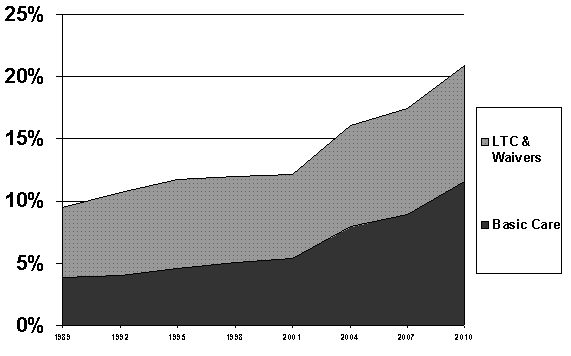
Basic health care spending in the state’s public health programs has risen more rapidly than overall inflation, just as it has in the privately insured programs. Cost increases have been attributed to a variety of factors, including increased caseload, increased use of services, more expensive technologies and pharmaceuticals, and increasing rates of chronic and disabling health conditions in the population, due to age, poor health or other disabilities. In recent years, physician and inpatient hospital costs have been driving cost growth most strongly. The state does put limits on the amount paid to providers to control spending growth. In response, some providers are beginning to refuse to serve public health care programs saying the reimbursement rates are to low, relative to their costs.
Looking at spending trends within the basic health care programs, spending has grown somewhat more rapidly on services for the elderly and disabled than for families and children over the last 20 years.
State Share Basic Health Care Costs
as a Percent of Total State General Fund FY 89-FY11 (projected)
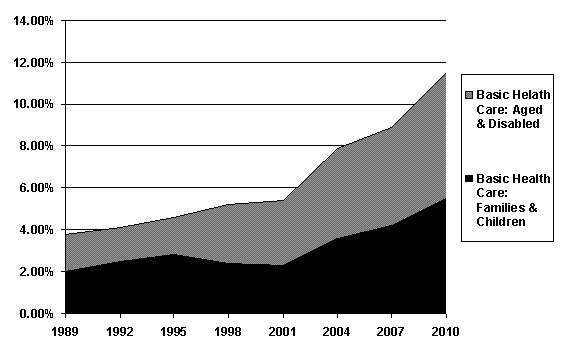
Although spending has grown rapidly in the basic health care program, it still remains less costly on a per person basis than long term care, especially for children and families.
In FY 07, there were more than twice as many children and families (356,000) receiving basic health care through MA than elderly and disabled people receiving basic health care and/or long term care (154,000); but total expenditures for basic health care for children and families represented one-fourth ($670,000) of total MA spending ($2.8 billion).
Children & Families Basic Care vs. LTC & Elderly/Disable Basic Care
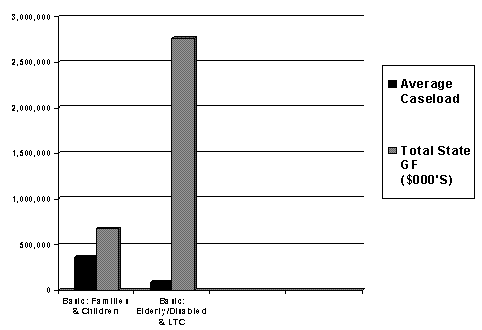
Source: DHS February 2008 Forecast
Although the monthly average payments made on behalf of those receiving basic health care are substantially lower than the average payments made to those in long-term care programs, the much higher enrollment of people in basic health care programs results in total expenditures comparable across the four categories.
Medical Assistance: Basic Health Care v. Long Term Care Costs (FY 07)
|
|
Average Monthly Payments |
Total State Share Costs |
|
Basic Health Care: Families & Children |
$321 |
$672 M |
|
Basic Health Care: Elderly & Disabled |
$823 |
$745 M |
|
Long Term Care Waivers |
$3,069 |
$846 M |
|
Long Term Care Facilities |
$3,857 |
$499 M |
Source: DHS February 2008 Forecast
Long term care MA spending has seen a major shift from spending on institutional care to waivered home and community based care, as the state has added options and the population has aged.
State Share Long Term Care Costs
as a Percent of Total State General Fund FY 89-FY11 (projected)
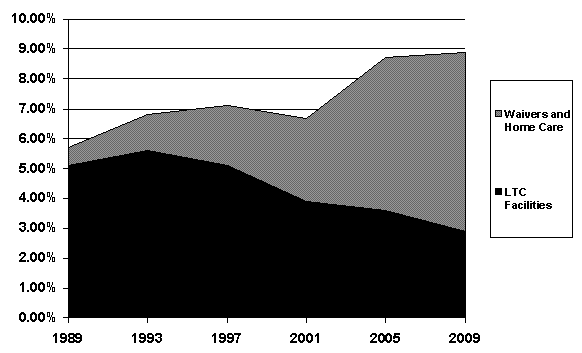
Since 1989, for instance, the number of average monthly recipients in nursing homes dropped by a third—from 27,000 to 18,000 (projected for FY11). Caseloads in ICF-MRs dropped by two thirds—from 4,000 to 1500. In contrast, monthly average recipients for waivered services and home care, on the other hand, grew nearly seven fold–from 8,500 to 57,000 (projected for FY11).
Spending on the Developmental Disabilities and the PCA/Private Duty nursing programs has grown most rapidly. They are the most costly of the waivered/home care services.
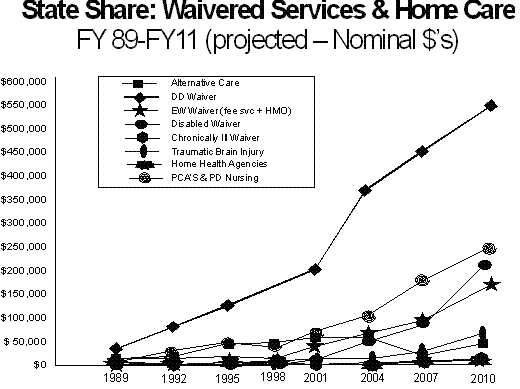
Projected spending for health care programs is figured in the budget forecasts released by the state economist every year. This is different from most of the rest of the budget, where projected spending is prior years’ spending carried forward without accounting for expected changes due to inflation or caseload changes.
Written October 2008 using public available information from the 2008 February Economic Forecast and data from the MN Department of Human Services.

